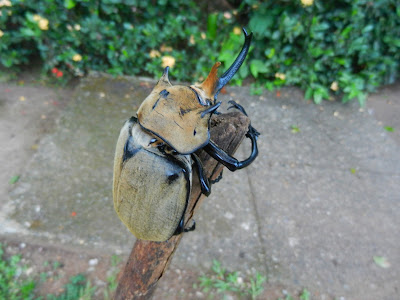More big beetles!
In April, I had come across a large male Harlequin Beetle, Acrocinus longimanus, a beautiful longhorn beetle with ornate markings, at the Canopy Bed & Breakfast in Gamboa. A few days ago, again at the B&B, I found another large beetle lying on its back under the house. This time, it was an Elephant Beetle! This was early in the morning and it had been attracted to the lights of the B&B at some point overnight. I helped the struggling beetle right itself, then, as I have learned not to go anywhere without my camera, placed it on a stick to take some photos.
 |
| Elephant Beetle |
The Elephant Beetle, Megasoma elephas, is a large, heavy-bodied beetle of Central and South America. It is a member of the Scarabaeidae family, a large family of beetles that includes the impressive Hercules Beetles, stag beetles, june beetles, dung beetles and many more. Both male and female Elephant Beetles are black with a thick layer of microscopic hairs that make it appear a yellow or tan colour. Males are 2-3 times larger than females, and have two prominent horns extending forward from their head and one from their prothorax, which are used for defense in competition for food and mates. Elephant beetles eat sap, fruit (and are particularly fond of pineapple) and bark. Their larvae are particularly large and live in decaying logs, taking up to 3 years to develop into adults! The larvae are very large, c-shape and white or yellowish in colour. Once the larvae pupate into adults, adults live for only one to three months.
 |
| Elephant Beetle |
Always something interesting to find here!
~ Jenn


No comments:
Post a Comment